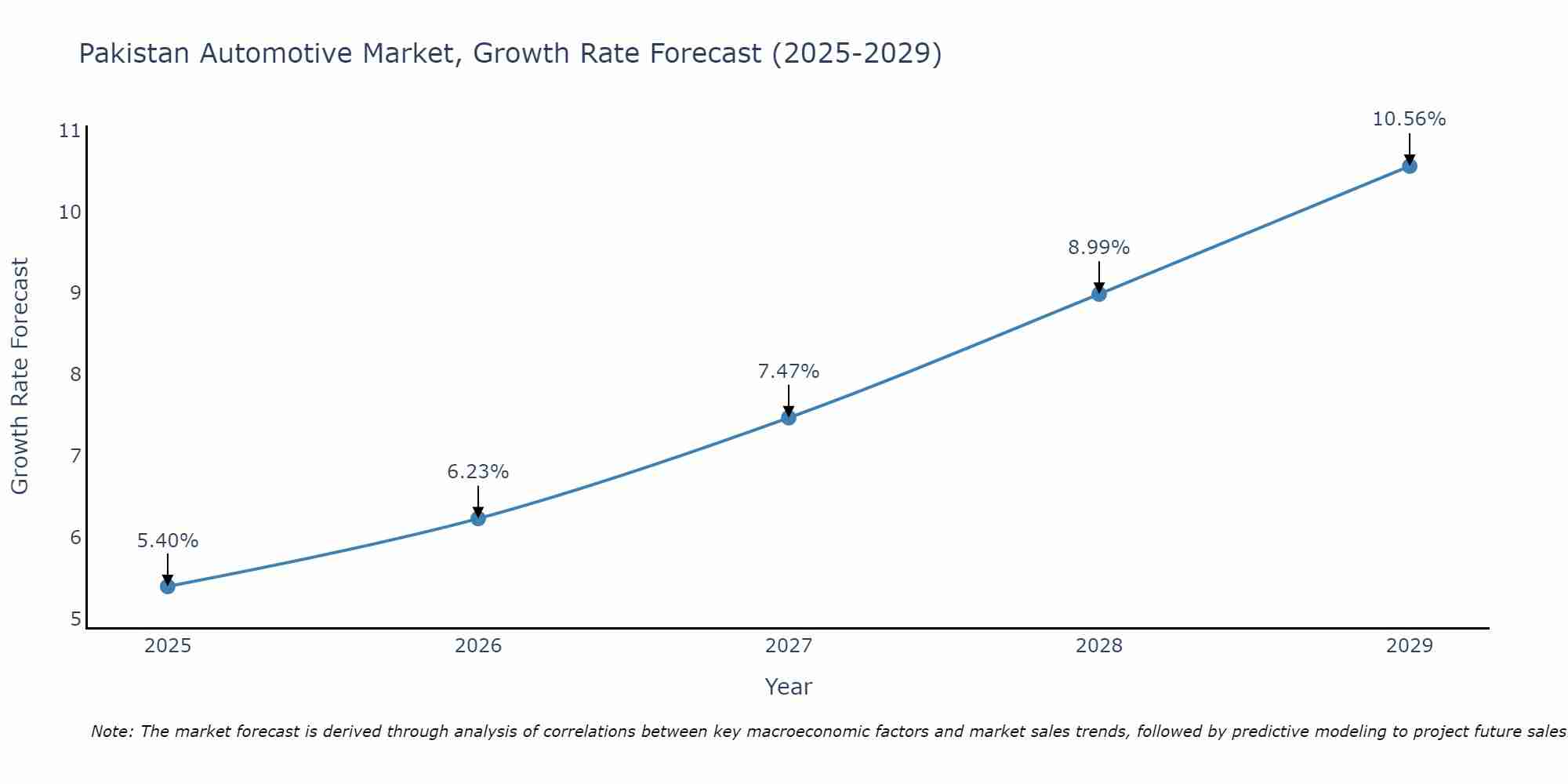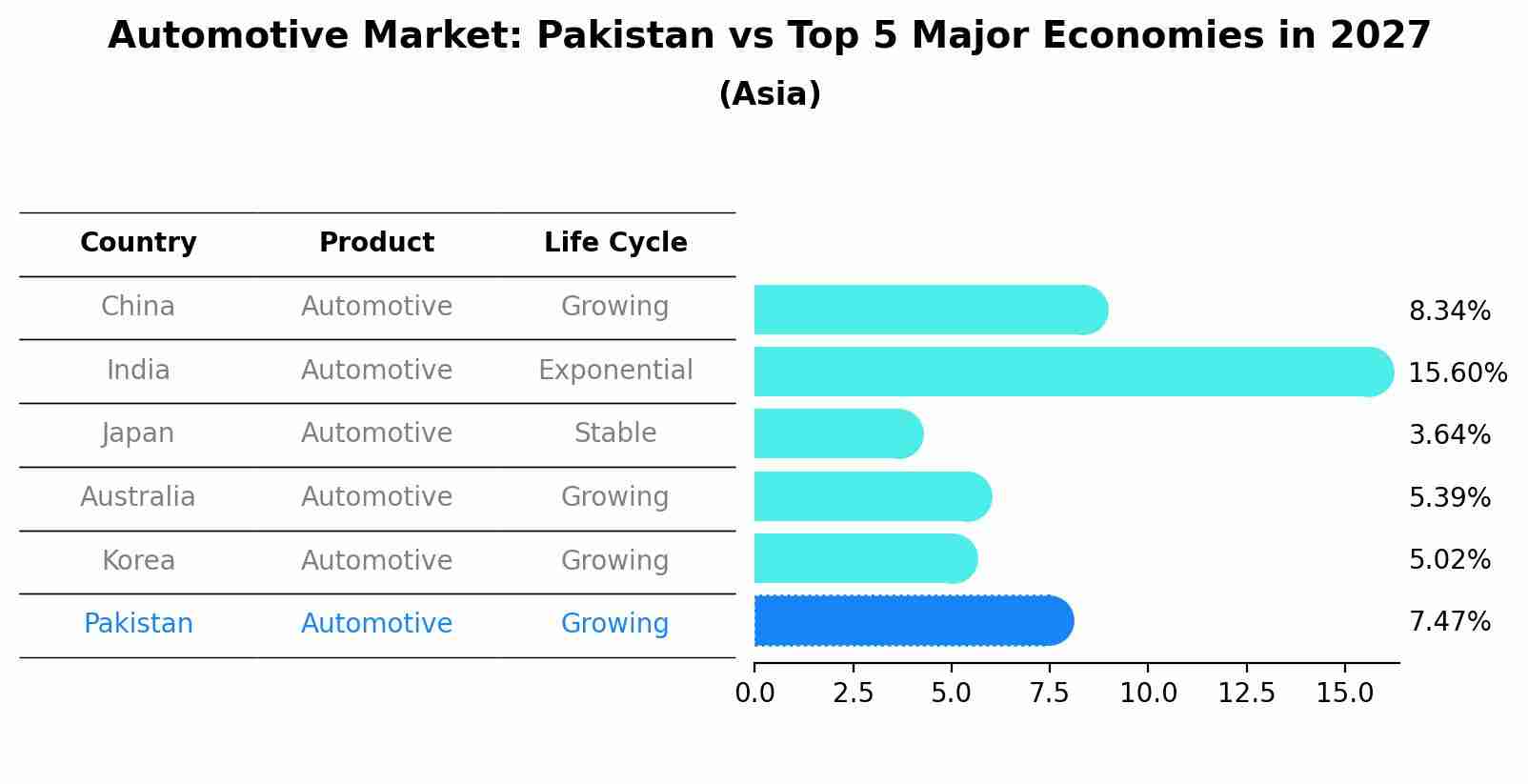Pakistan Automotive Market Outlook | Revenue, Industry, Trends, Size, COVID-19 IMPACT, Forecast, Analysis, Share, Growth, Companies & Value
| Product Code: ETC431793 | Publication Date: Oct 2022 | Updated Date: Jul 2025 | Product Type: Market Research Report | |
| Publisher: 6Wresearch | Author: Ravi Bhandari | No. of Pages: 75 | No. of Figures: 35 | No. of Tables: 20 |
Pakistan Automotive Market Size Growth Rate
The Pakistan Automotive Market is poised for steady growth rate improvements from 2025 to 2029. The growth rate starts at 5.40% in 2025 and reaches 10.56% by 2029.

Automotive Market: Pakistan vs Top 5 Major Economies in 2027 (Asia)
The Automotive market in Pakistan is projected to grow at a growing growth rate of 7.47% by 2027, within the Asia region led by China, along with other countries like India, Japan, Australia and South Korea, collectively shaping a dynamic and evolving market environment driven by innovation and increasing adoption of emerging technologies.

Pakistan Automotive Market Synopsis
The Pakistan Automotive Market is experiencing steady growth driven by factors such as a rising middle-class population, increasing disposable income, and improved road infrastructure. The market is dominated by local manufacturers such as Toyota, Honda, and Suzuki, with a growing presence of international brands like Hyundai and Kia. Passenger cars make up the largest segment of the market, followed by commercial vehicles and motorcycles. With a rapidly expanding population and urbanization, there is a growing demand for affordable and fuel-efficient vehicles in Pakistan. However, challenges such as high import duties, fluctuating exchange rates, and government policies regarding the automotive industry pose obstacles to further market expansion. Overall, the Pakistan Automotive Market presents opportunities for both local and international players looking to capitalize on the country`s growing automotive sector.
Pakistan Automotive Market Trends
In the Pakistan Automotive Market, some current trends include a growing demand for hybrid and electric vehicles as consumers become more environmentally conscious and seek fuel-efficient options. Additionally, there is a shift towards more advanced safety features and technology integration in vehicles to enhance the overall driving experience. The market is also witnessing an increase in the popularity of SUVs and crossovers, reflecting changing consumer preferences towards larger and more versatile vehicles. Furthermore, there is a focus on enhancing manufacturing processes and local production to reduce costs and improve competitiveness in the market. Overall, these trends indicate a dynamic and evolving automotive market in Pakistan that is adapting to global trends and consumer demands.
Pakistan Automotive Market Challenges
The Pakistan Automotive Market faces several challenges, including inconsistent government policies, high taxes on imported vehicles, fluctuating exchange rates, and increasing competition from used car imports. Additionally, the lack of proper infrastructure, such as road networks and traffic management systems, hinders the growth and development of the automotive industry in Pakistan. Limited access to financing options for consumers also poses a challenge, as purchasing a new vehicle often requires a significant upfront investment. Furthermore, issues related to energy efficiency and environmental regulations add to the complexity of operating in the Pakistani automotive market. Overall, these challenges create a difficult environment for automotive manufacturers and dealers to navigate and succeed in Pakistan.
Pakistan Automotive Market Investment Opportunities
The Pakistan Automotive Market presents various investment opportunities across different segments. With a growing population and increasing disposable income levels, there is a rising demand for vehicles in the country. Investing in the manufacturing and assembly of automobiles, especially in partnership with established global brands, can be lucrative. Additionally, there is potential in the electric vehicle (EV) segment as the government aims to promote cleaner transportation solutions. Supporting infrastructure development for EVs, such as charging stations, also offers investment prospects. Furthermore, opportunities exist in the aftermarket industry for spare parts, accessories, and maintenance services to cater to the expanding vehicle fleet. Overall, the Pakistan Automotive Market shows promise for investors looking to capitalize on the country`s evolving automotive landscape.
Jordan Agar Market Government Policies
Government policies related to the Pakistan Automotive Market include the Auto Development Policy (ADP) 2016-2021, which aims to attract investment and promote local manufacturing in the automotive sector. The policy provides incentives for new entrants, such as reduced duties on imports of plant and machinery, as well as tax breaks for localization of production. Additionally, the government has implemented various measures to encourage the production of electric vehicles, including tax exemptions and subsidies for manufacturers. However, the industry also faces challenges such as high import duties on completely built units (CBUs) and parts, as well as fluctuating exchange rates and economic instability. Overall, the government is working to support the growth and development of the automotive market in Pakistan through a combination of incentives and regulations.
Pakistan Automotive Market Future Outlook
The Pakistan Automotive Market is poised for growth in the coming years due to various factors such as increasing disposable income, expanding middle-class population, and government initiatives to promote the automotive industry. The market is expected to witness a rise in demand for vehicles, particularly in the passenger car and commercial vehicle segments. Additionally, the shift towards electric vehicles and the introduction of more fuel-efficient and environmentally friendly vehicles are likely to shape the future of the market. However, challenges such as regulatory changes, infrastructure development, and competition from imported vehicles may impact the growth trajectory. Overall, the Pakistan Automotive Market shows great potential for expansion and innovation in the coming years, making it an attractive market for both domestic and international automotive manufacturers.
Key Highlights of the Report:
- Pakistan Automotive Market Outlook
- Market Size of Pakistan Automotive Market, 2021
- Forecast of Pakistan Automotive Market, 2031
- Historical Data and Forecast of Pakistan Automotive Revenues & Volume for the Period 2018 - 2031
- Pakistan Automotive Market Trend Evolution
- Pakistan Automotive Market Drivers and Challenges
- Pakistan Automotive Price Trends
- Pakistan Automotive Porter's Five Forces
- Pakistan Automotive Industry Life Cycle
- Historical Data and Forecast of Pakistan Automotive Market Revenues & Volume By Product Type for the Period 2018 - 2031
- Historical Data and Forecast of Pakistan Automotive Market Revenues & Volume By Electric for the Period 2018 - 2031
- Historical Data and Forecast of Pakistan Automotive Market Revenues & Volume By Hybrid Electric for the Period 2018 - 2031
- Historical Data and Forecast of Pakistan Automotive Market Revenues & Volume By Plug-In Hybrid Electric for the Period 2018 - 2031
- Historical Data and Forecast of Pakistan Automotive Market Revenues & Volume By Mild Hybrid for the Period 2018 - 2031
- Historical Data and Forecast of Pakistan Automotive Market Revenues & Volume By Natural Gas for the Period 2018 - 2031
- Historical Data and Forecast of Pakistan Automotive Market Revenues & Volume By Fuel Cell Electric for the Period 2018 - 2031
- Historical Data and Forecast of Pakistan Automotive Market Revenues & Volume By Diesel for the Period 2018 - 2031
- Historical Data and Forecast of Pakistan Electric Automotive Market Revenues & Volume By Petrol for the Period 2018 - 2031
- Pakistan Automotive Import Export Trade Statistics
- Market Opportunity Assessment By Product Type
- Pakistan Automotive Top Companies Market Share
- Pakistan Automotive Competitive Benchmarking By Technical and Operational Parameters
- Pakistan Automotive Company Profiles
- Pakistan Automotive Key Strategic Recommendations
Frequently Asked Questions About the Market Study (FAQs):
- Single User License$ 1,995
- Department License$ 2,400
- Site License$ 3,120
- Global License$ 3,795
Search
Related Reports
- Portugal Electronic Document Management Market (2025-2031) | Strategy, Consumer Insights, Analysis, Investment Trends, Opportunities, Growth, Size, Share, Industry, Revenue, Segments, Value, Segmentation, Supply, Forecast, Restraints, Outlook, Competition, Drivers, Trends, Demand, Pricing Analysis, Competitive, Strategic Insights, Companies, Challenges
- France Electronic Document Management Market (2025-2031) | Strategy, Consumer Insights, Analysis, Investment Trends, Opportunities, Growth, Size, Share, Industry, Revenue, Segments, Value, Segmentation, Supply, Forecast, Restraints, Outlook, Competition, Drivers, Trends, Demand, Pricing Analysis, Competitive, Strategic Insights, Companies, Challenges
- Portugal Occupational Health & Safety Services Market (2025-2031) | Strategy, Consumer Insights, Analysis, Investment Trends, Opportunities, Growth, Size, Share, Industry, Revenue, Segments, Value, Segmentation, Supply, Forecast, Restraints, Outlook, Competition, Drivers, Trends, Demand, Pricing Analysis, Competitive, Strategic Insights, Companies, Challenges
- Netherlands Occupational Health and Safety Services Market (2025-2031) | Strategy, Consumer Insights, Analysis, Investment Trends, Opportunities, Growth, Size, Share, Industry, Revenue, Segments, Value, Segmentation, Supply, Forecast, Restraints, Outlook, Competition, Drivers, Trends, Demand, Pricing Analysis, Competitive, Strategic Insights, Companies, Challenges
- Belgium and Luxembourg Facility Management Market (2025-2031) | Strategy, Consumer Insights, Analysis, Investment Trends, Opportunities, Growth, Size, Share, Industry, Revenue, Segments, Value, Segmentation, Supply, Forecast, Restraints, Outlook, Competition, Drivers, Trends, Demand, Pricing Analysis, Competitive, Strategic Insights, Companies, Challenges
- Russia Women Intimate Apparel Market (2025-2031) | Strategy, Consumer Insights, Analysis, Investment Trends, Opportunities, Growth, Size, Share, Industry, Revenue, Segments, Value, Segmentation, Supply, Forecast, Restraints, Outlook, Competition, Drivers, Trends, Demand, Pricing Analysis, Competitive, Strategic Insights, Companies, Challenges
- Africa Chocolate Market (2025-2031) | Size, Share, Trends, Growth, Revenue, Analysis, Forecast, industry & Outlook
- Global Hydroxychloroquine And Chloroquine Market (2025-2031) | Industry, Trends, Size, Outlook, Growth, Value, Companies, Revenue, Analysis, Share, Forecast
- Saudi Arabia Plant Maintenance Market (2025-2031) | Industry, Size, Growth, Revenue, Value, Companies, Forecast, Analysis, Share & Trends
- Taiwan Electric Truck Market (2025-2031) | Outlook, Industry, Revenue, Size, Forecast, Growth, Analysis, Share, Companies, Value & Trends
Industry Events and Analyst Meet
Our Clients
Whitepaper
- Middle East & Africa Commercial Security Market Click here to view more.
- Middle East & Africa Fire Safety Systems & Equipment Market Click here to view more.
- GCC Drone Market Click here to view more.
- Middle East Lighting Fixture Market Click here to view more.
- GCC Physical & Perimeter Security Market Click here to view more.
6WResearch In News
- Doha a strategic location for EV manufacturing hub: IPA Qatar
- Demand for luxury TVs surging in the GCC, says Samsung
- Empowering Growth: The Thriving Journey of Bangladesh’s Cable Industry
- Demand for luxury TVs surging in the GCC, says Samsung
- Video call with a traditional healer? Once unthinkable, it’s now common in South Africa
- Intelligent Buildings To Smooth GCC’s Path To Net Zero













